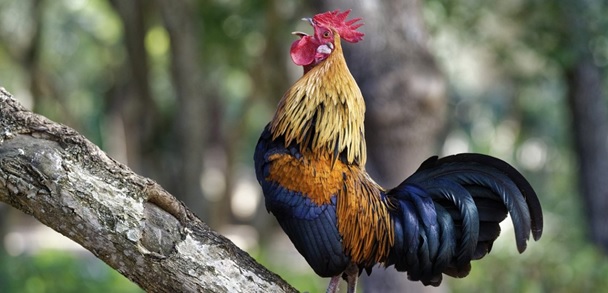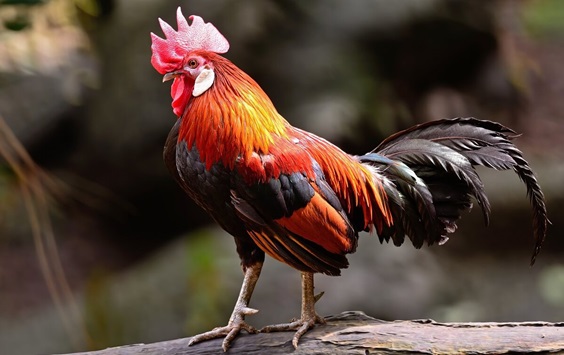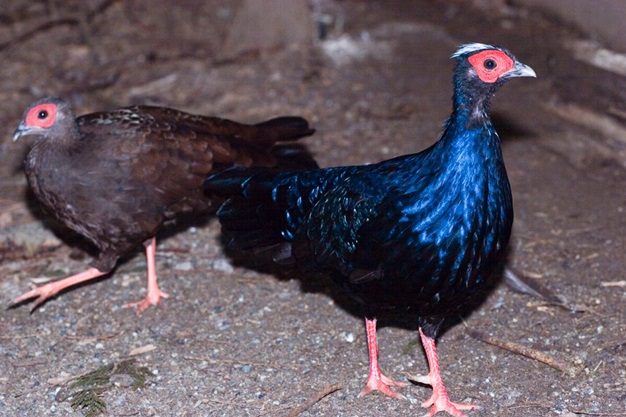The King of the Dawn 拂曉之帝
By Shaun Hurrell, BirdLife International
作者:Shaun Hurrell 國際鳥盟
王學思翻譯


Male Red Junglefowl in its natural habitat身處自然生境的紅原雞雄鳥 © Philip Pikart
Awaken to the sound of the rooster. Hard work and good fortune are ahead. Celebrate the Chinese New Year by recognising the only bird in the Chinese zodiac.
中國傳統十二生肖中唯一的鳥類 紅雞報曉, 慶祝中國農曆新年!祝願大家雞年努力工作!事事如意!
It’s a “cock-a-doodle-do” in the USA, a “konkoliirikoo” in Ghana, “kuckelikuuu” in Sweden, “chicchi-ri-chììì” in Italy, “O-O” in China… as dawn breaks around the world, somewhere, everywhere, there is a rooster waking up a human.
「喔喔喔喔」,天亮了,不論是美國、加納、瑞典、意大利,還是中國,世界各地總有公雞的啼聲把人喚醒。
There’s probably no other bird that is so much part of human life. For the world’s 7.5 billion people, there are over 12 billion chickens – making them the world’s most abundant bird. But they are much more than that biologically, culturally and spiritually, and today marks the start of the Year of the Rooster, which, according to the Chinese zodiac, will bring good luck, wisdom, bravery, and hard work.
在人類生活史上,雞與我們的緊密關係實在無出其右,雞是世界上數量最多的鳥,75億人中便有超過120億隻雞。雞的地位不單反映在飲食、文化和精神的層面,牠更是中國傳統十二生肖之一,代表吉祥、智慧、勇氣和勤奮。
And if you’re thinking “it’s just a chicken,” having being habituated to their ubiquity since childhood nursery rhymes, stop… and look again. Beyond the source of meat and eggs, beyond the clucks and cruelty of battery farms: do these extravagant-looking birds look out of place in farm or village, almost like a pheasant?
雞除了令人聯想起兒歌「何家公雞何家猜」、雞肉、雞蛋、「咯咯咯」的母雞叫聲,或殘酷的層架式雞場外,當牠遠離農場或鄉村時,雞彷彿成了一隻外表華麗的雉雞。
Imagine: some 7,000 years ago, one of our ancestors is treading lightly through a lushly-forested part of Asia. Suddenly, a rustle in the leaf litter… thick avian claws are scratching through the undergrowth for insects. If you’d seen Jurassic Park, you’d compare them to the agile and slashing legs of a velociraptor. But instead you look up and see feathers the colour of sunrise, a magnificent scarlet fleshy crown on the male, and large, strong breast muscles (used for sprint-flapping into the trees away from danger). The experience of seeing these wild junglefowl could have either been beautifully meaningful, or your lucky day for a wholesome meal – if you wanted and could catch it.
試想想,大約7千年前,我們的祖先正在穿越亞洲一片茂密的森林,突然聽到樹葉間傳來沙沙聲,一對粗壯的鳥爪正在灌木叢中尋找昆蟲,正如電影「侏羅紀公園」的速龍那對敏捷剛勁的腳。當你繼續往上看,顏色鮮艷且帶光澤的羽毛覆蓋在一隻雄鳥身上,頭上一頂如火焰般的大肉冠,還有大而強壯的胸肌(用於短距離飛奔入樹林以逃避危險)。假如你在野外遇到這美麗的野生原雞,這是一件美妙的事, 若你夠運能捕捉牠們, 就能享用一頓健康的大餐。
From this day forward, the Red Junglefowl Gallus gallus, which are closely related to pheasants in the family Phasianidae, was domesticated, hybridised and integrated into human culture as the chicken we know today. From Asia they have spread westwards (and eastwards) through time to be associated with every human community, apart from perhaps the Inuit. For better or for worse, the junglefowl was first appreciated for more than just its meat – originally for recreation (cockfighting) and for predicating the future, and its stunning plumage has also been used for ornamentation.
從此,與雉同屬雉科的紅原雞(Red Junglefowl Gallus gallus)開始被馴養、雜交並融入人類文化中成為我們今天熟悉的家禽。此後,牠們從亞洲向西(和向東)不斷擴散,並開始進入人類每個社會,除了因紐特人(Inuit)外。原雞最初受人歡迎的原因並不是只因為牠的肉,而是作為鬥雞等娛樂活動及占卜之用,令人目眩的羽毛也被用於裝飾用途。
It’s easy to see how this bird has come to be associated with goodness in life. One of twelve animals in the Chinese zodiac, the rooster (cockerel, or male chicken) has general characteristics of hard work, good luck and virtue. In Chinese, the world “luck” and “cock” have the same pronunciation: Ji. Vivian Fu, Assistant Manager of BirdLife's China Programme, says: "The rooster represents wisdom (because of its crown), bravery (their boldness in fights), kindness (owing to their social nature of sharing food), and faith (they call every morning)."
人類社會常常把雞與吉祥扯上關係。公雞是中國傳統十二生肖之一,寓意勤奮、吉祥和美德。普通話的「吉」和「雞」發音相同。國際鳥盟與香港觀鳥會合作的中國項目的助理經理傅詠芹說:「公雞代表智慧(牠頭上有冠)、勇敢(足後有距能鬥)、善良(有食物招呼同類)和信譽(每天早上報曉)。」
And without the call of the cockerel waking up humankind at dawn, maybe, our species would have been a lot less productive.
假如沒有公雞在天亮時喚醒我們,也許人類的生產力會大大減少。
The Asian perspective on chickens is somewhat refreshing. In some “Western” cultures this common bird is a synonym of being “faint-hearted”, and to human carnivores its meat is perceived as somewhat “inferior” (even to some birders… they’re hardly a bird anymore). While the truth is that these birds are a reliable, precious source of “lean” protein for billions of people, and from a climate change perspective, they are a far less damaging species to breed than cattle.
亞洲人對雞的觀點往往令西方人耳目一新,在一些「西方」文化中,雞這種常見的鳥象徵「懦弱」,吃葷的人認為雞肉屬「低級」肉類,(一些觀鳥者甚至認為雞並不算是鳥)。但事實上,雞為數十億人提供可靠及寶貴的蛋白質,雞肉的脂肪含量又較低,飼養雞比飼養牛對氣候變化帶來的壞處亦較輕。
Conservation of the most numerous bird on the planet?保護地球上最多的鳥?


The Red Junglefowl's elegant plumage紅原雞漂亮的羽毛 © Panu Ruangjan
Well, the domesticated chicken, technically – whilst thought to be “mostly” Red Junglefowl – is a hybrid of other Asian junglefowl species, and through selective breeding is not quite the slim, agile tree-rooster of its wilder relatives. It is also thought to take its characteristic yellow legs from the Grey Junglefowl Gallus sonneratii of India. For the IUCN Red List however, for which BirdLife is the authority on birds, the domesticated chicken in effect constitutes an introduced species worldwide and therefore does not meet criteria for assessment. But look on Datazone, and you’ll find that Red Junglefowl is listed as Least Concern, along with the three other junglefowl species. These wild junglefowl still live in Asian forests but are so numerous that they are not of conservation concern. That said, there are fears that domesticated chickens left to roam are mixing with wild junglefowl at forest edges and could one day hybridise the species out of existence. And in Singapore, where the rooster’s association with punctuality and prosperity is prominent in the Garden City’s development, there is little remaining forest cover, and wild Red Junglefowl are worryingly endangered.
過去一般相信家雞主要源自紅原雞,但近年有研究指出家雞是多種不同亞洲原雞的混種,經人工選擇繁殖而得來。此外,家雞的黃色足部被認為是源自印度的灰原雞(Grey Junglefowl Gallus sonneratii)。負責IUCN紅色名錄鳥類部分的國際鳥盟評定家雞是一種在世界廣泛分布的引入物種,因此並不符合IUCN紅色名錄的評估標準。但在國際鳥盟的網頁的資料庫中,紅原雞及其他三個原雞品種均被列為無危。這些野生原雞仍然生活在亞洲的森林中,而且因數量眾多而不受保育關注。但令人擔憂的是在野外遊走的家雞有機會走到森林邊緣與野生原雞雜交,最終導致純種的野生原雞消失。新加坡的原雞明顯受到城市發展的影響,這個「花園城市」的樹木管理工作,令當地只剩餘少量森林,令野生紅原雞有趨向瀕危的隱憂。
In Vietnam, a Critically Endangered bird of the same family, Edwards's Pheasant Lophura edwardsi, is tied to the fate of the Red Junglefowl, where indiscriminate trapping for more resilient species like the junglefowl is severely threatening the pheasant, which is just about hanging on in very small fragments of forest (due to past herbicide spraying during the Vietnam War, logging and clearance for agriculture). Viet Nature (BirdLife in Vietnam) is working on a project to save Edward's Pheasant from extinction. In the rest of Asia, through BirdLife’s work to protect Important Bird & Biodiversity Areas (IBAs) that includes thousands of identified forest sites where wild junglefowl are found, for example Western Siem Pang in Cambodia, and Harapan Forest in Indonesia, we are working to ensure the chicken’s wild ancestors’ “ku-ku-ruyuks” (which, apparently, are more high-pitched and end more abruptly than the domesticated rooster’s) continue to herald dawn, productivity, prosperity and luck forever more.在越南,由於當地人不加選擇地捕捉原雞等適應力強的鳥種,禍及同屬雉科但極度瀕危的愛氏鷴(Edwards's Pheasant Lophura edwardsi)受到嚴重威脅。愛氏鷴只生活於越南的森林,由於越南戰爭期間大量使用落葉劑,再加上伐木和農地開發的破壞,令到越南只殘餘一些面積非常細小的森林。Viet Nature(國際鳥盟在越南的代表)正開展一個拯救瀕危愛氏鷴的項目。在亞洲其他地區,國際鳥盟致力保護重點鳥類和生物多樣性地區(IBAs),當中包括上千個確認有野生原雞生活的森林,例如柬埔寨的暹龐西部和印度尼西亞的天堂森林。我們正努力確保家雞的野生祖先的啼聲“ku-ku-ruyuks”能繼續「拂曉時分,雞鳴四起」,世代繁衍及永遠吉祥。


Don't count your chickens... Edward's Pheasant 愛氏鷴© Myles Lamont, World's Rarest Birds


